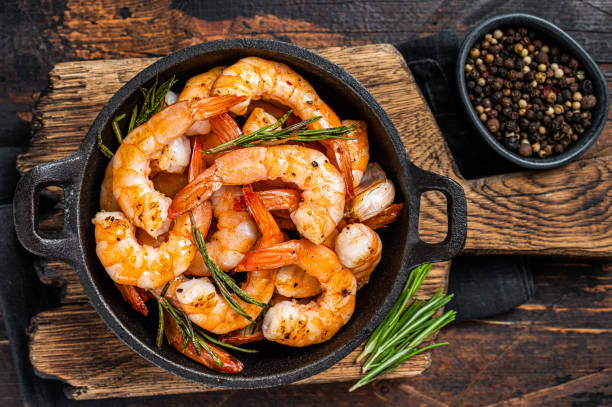This content is for informational and educational purposes only. Always consult a qualified healthcare provider.
Last Updated on January 31, 2025 by Grace Oluchi
What Is Shrimp Food Poisoning?
Shrimp food poisoning occurs when you consume contaminated shrimp due to improper handling, storage, or cooking. Harmful bacteria, viruses, and parasites can cause severe foodborne illnesses if not properly managed. This guide covers everything you need to know, from symptoms to prevention tips, and provides expert-backed recommendations to stay safe while enjoying seafood.
📋 Table of Contents
Symptoms of Shrimp Food Poisoning
Symptoms may appear 4–48 hours after consumption and range from mild to severe:
Mild Symptoms
- Nausea
- Vomiting
- Diarrhea
- Abdominal pain
- Cramps
Severe Symptoms
- Bloody stools (indicates severe bacterial infection)
- Dehydration (dry mouth, dizziness, low urine output)
- High fever & chills (sign of systemic infection)
- Neurological symptoms (dizziness, muscle weakness in severe cases)
🚨 When to Seek Medical Help 🚨
- Persistent vomiting or diarrhea lasting more than 24 hours
- Severe dehydration symptoms (dizziness, confusion)
- High fever above 101.5°F (38.6°C)
Causes of Shrimp Food Poisoning
Food poisoning from shrimp is primarily caused by:
- Vibrio parahaemolyticus – Found in raw or undercooked shrimp.
- Norovirus – A leading cause of foodborne illnesses.
- Salmonella – Linked to improperly stored seafood.
- Hepatitis A – Can spread through contaminated shellfish.
- Parasites – Common in raw or undercooked shrimp.
Did You Know?
Vibrio bacteria thrive in warm coastal waters and peak in summer months. Always inquire about sourcing when purchasing shrimp.
What to Do After Eating Bad Shrimp
If you suspect food poisoning:
- Stay Hydrated – Sip clear fluids (water, broth, electrolyte drinks).
- Seek Medical Help – Especially if symptoms worsen.
- Avoid Anti-Motility Drugs – Allow your body to expel toxins naturally.
📌 Emergency Tip: If symptoms persist, hospitalization may be required for IV fluids and infection control.
How to Prevent Shrimp Food Poisoning
1. Identify Fresh Shrimp
- Clear, shiny eyes and firm texture indicate freshness.
- Avoid shrimp with a sour or ammonia-like smell.
2. Buy from Trusted Sources
- Choose wild-caught shrimp certified by sustainable seafood programs.
- Prefer frozen shrimp over fresh if unsure about sourcing.
3. Store Properly
- Keep at or below 40°F (4°C).
- Consume within 1-2 days or freeze immediately.
4. Cook Thoroughly
- Safe internal temperature: 145°F (63°C).
- Fully cooked shrimp turn opaque and curl into a “C” shape.
5. Prevent Cross-Contamination
- Use separate cutting boards for shrimp and other foods.
- Wash hands and utensils before and after handling raw seafood.
📌 Quick Tip: Freezing shrimp slows bacterial growth but does not eliminate bacteria entirely. Always cook shrimp thoroughly after thawing.
Case Study: 2023 Vibrio-Related Food Poisoning Outbreak
A Florida restaurant experienced a Vibrio-related food poisoning outbreak due to improperly cooked shrimp. Over 30 patrons reported severe symptoms like diarrhea, abdominal cramps, and fever. Investigators found the shrimp was stored above safe temperatures and not cooked to recommended guidelines.
Key Takeaway: This outbreak highlights the importance of strict seafood handling and proper cooking techniques to prevent illness.
FAQs About Shrimp Food Poisoning
How long does it take for symptoms to appear?
Symptoms usually develop 4–48 hours after eating contaminated shrimp.
Can shrimp food poisoning be fatal?
Yes, severe cases (especially involving Vibrio bacteria) can be life-threatening.
Is there a cure for shrimp food poisoning?
No direct cure exists. Treatment focuses on hydration and symptom management.
What are the risks of undercooked shrimp?
Undercooked shrimp can harbor bacteria and parasites, increasing the risk of illness.
Who is most at risk?
Pregnant women, children, elderly individuals, and those with weakened immune systems are at the highest risk.
📌 Additional Resources
🔗 FDA Guidelines on Seafood Safety
🔗 WHO Food Safety Standards
🔗 CDC Insights on Foodborne Illness
How long does it take for symptoms to appear?
Symptoms usually develop 4–48 hours after eating contaminated shrimp.
Can shrimp food poisoning be fatal?
Yes, severe cases can be life-threatening, especially in vulnerable groups.
Is there a cure for shrimp food poisoning?
No direct cure exists; supportive care like hydration and rest is key.
What are the risks of undercooked shrimp?
Undercooked shrimp can harbor bacteria and parasites, increasing the risk of illness.
Who is most at risk?
Pregnant women, children, the elderly, and immunocompromised individuals.

